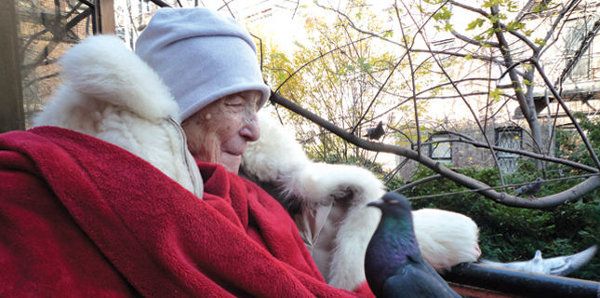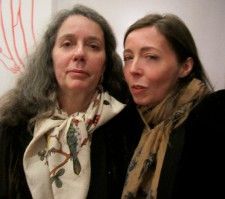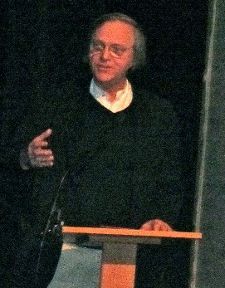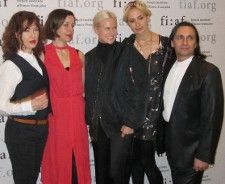
On International Women’s Day, Grabigouji: Life of Disappearance, Brigitte Cornand's intimate and haunting portrait of artist and sculptor Louise Bourgeois had its US premiere on Friday, March 8, at New York's French Institute Alliance Française. It was presented as part of her My Beautiful Women series, which celebrates female artists through film. I met up with her in the theatre before the sneak preview screening for a conversation during the opening reception for Manifesto, featuring artists Ellen Berkenblit, Haley Mellin, Olympia Scarry, Lola Montes Schnabel, & Ena Swansea, co-curated by Vogue Style Editor-at-Large Elisabeth von Thurn und Taxis & Tony Guerrero, Director of Visual Arts at FIAF.
Following our conversation, Robert Storr, Dean of the Yale University School of Art and a former Senior Curator at the Museum of Modern Art introduced the film to a sold-out audience.
Anne-Katrin Titze: Is there a kernel for your film? I was wondering if you started from an image, the fact that it was meant as a birthday present to your friend, or one of the phone messages. What was the beginning?

Brigitte Cornand: I worked with Louise for years and before she unfortunately passed away (May 31, 2010, at 98), I suggested to her to make a new movie, a new portrait for her 100th birthday. Then she passed away and I had to change my plan. I was going to show her making work or something and I decided not to see her so much in the film but to hear the voice because I recorded many conversations we had between Paris and New York.
AKT: Did you record all your phone conversations?
BC: It was like a back and forth. When I was with Louise, I used to call her two times a day. And when I was travelling in Paris, I also had to call her twice a day. So I thought maybe the voice and the conversation could make something interesting. It could be like a walk between what she liked in Paris, because she grew up in France, and what I bring back to her, because she asked me to go places for her and see people. And this is what I did. I decided not to show so many works of art but kind of abstract landscape. The house empty to provoke something moving.
AKT: Missing her?
BC: Missing her.
AKT: There is a house. We hear her voice.
BC: But she is gone.
AKT: A work of mourning. A coming to terms with her being gone? Not in a gloomy way, though. There are so many flowers in your film and nature.
BC: That's where I live. I use everything next to me.
AKT: Where did you shoot the scenes in nature?

BC: I live partly here and in Martha's Vineyard. That's where it was shot mostly. It's nearby the house. I wanted to show something abstract. Just the beauty of nature. Something simple.
AKT: To let us wander?
BC: Yes. I work by myself. Just with an editor. But I do everything.
AKT: And then you allow the audience to fill up the space with Louise's artworks in our imagination. I am the one who connects, let's say the Rockefeller Center spiders to the garden. The film lets us do the work.
BC: I have a lot of footage of her. It was like a kind of archaeology, coming back to the past. I think it was easier for me to work only with the voice. I thought about using a tape recording a long time ago and little by little this idea came out.
AKT: Can you explain the mysterious title?
BC: Grabigouji? It's children's language. It's a kind of onomatopoeia. It means absolutely nothing, but between Louise and myself it was a code name. When we become older, we are losing memory. We are losing everything - the words, the significance. She called me Grabigouji to say, "I'm fine". And I called her Grabigouji to say, "I see you - how are you?".
AKT: An extremely personal title. I found myself wondering, if we were ever going to meet this mysterious stranger, if Grabigouji is going to show up. I liked how you used Louise's entry in the Larousse Dictionary to give background and at the same time show her deserved pride. Very smart choice.
BC: Thank you. It was the first time I discovered she was in the dictionary. It was by chance. I bought a French dictionary and told her, "You are in it".
AKT: There was a name of a person Louise gave you to find. Did you do more research?

BC: Yes. I called the City Hall where she lived and they sent me back a paper after a few months. I never said no to Louise. I guess she didn't know who this person was any more. I'm guessing this person was working with Louise's father at his gallery. Germaine Martin was her name.
AKT: This part of your film is really universal. We all will at some point remember some name and not know how and why. Who are they? What is the power of a name? These questions go far beyond the portrait of one artist. The film is very much about memory and mourning.
BC: Memory, mourning and death.
AKT: The series of your films that will be shown here at the FIAF is called My Beautiful Women. Please explain the concept and the title.
BC: The title came from when I was making my film Red Birds. I wanted to do something with my girlfriend artists. I thought, I have to gather them into one film. At that time, the Pompidou Center organised a show called SHE and it was about women artists and they asked me if I could do a film. I started to call it My Beautiful Women and I changed my mind. I thought, I don't want to see them. I don't want to show that fantastic person doing this and doing that, in her studio and going outside, etc., etc. As I live part time in the countryside and I love birds and I film birds, I thought, why not filming birds and each woman will be a specific bird. And I changed the title and I kept this title for the festival.
AKT: How did you decide on which bird would go with which artist? (Like the little boy in Wes Anderson's Moonrise Kingdom, you may ask: What kind of bird are you?)
BC: You only hear the voice. Kiki Smith is a dove because a long time ago she had doves in her house. Joan Jonas is a song sparrow, no a white-throated sparrow, because it's like a comedian with a mask. Nancy Holt is a catbird because she's a cat lover. Carolee Schneeman is a robin - she's a performer. Annette Messager is a sparrow, because she used sparrows in her own artworks when she started. And Louise is a cardinal, of course. At the end to see them, I make a double screen, and on one side you see the artist on the other you see the bird.
AKT: Why Red Birds? They aren't all red.
BC: Because of the cardinal. And red means fire, means strength, revolution. Dear Louise is the first film I made with her, when we met in 1994. It's not academic, it's more performance, with a feminine poetic license. Then we did The Whisper Of The Whistling Water, which is the title of a song she wrote. Saint Louise and the Hawk a short, is one thing I did right before she passed away.
AKT: That is the last one?
BC: It's four minutes. People could think she is dead in the movie.
AKT: Grabigouji: Life of Disappearance is her but it's more.
BC: Yes, it's her but it's more. It's moving for everybody because you recognise something.
AKT: You, that is, your voice, is so calm in the film. Are you a very calm person?
BC: I have to be. In my work, yes, I am very patient. But, you know, I loved her. That's it.
You can see Brigitte Cornand's films on the following dates and times at the French Institute Alliance Française, 55 East 59th Street, New York City.
My Beautiful Women: The Films of Brigitte Cornand
Saturday, March 23
2pm In Annette Messager's Nets
3pm The Sweet River (Short) & Saint Louise and the Hawk
3:30 Annette Messager, The Messengers
4:40 Andrée Putman
Saturday, April 13
2pm Dear Louise
3pm The Red Birds
4:30 Joan Jonas: Portrait of the Artist with Dog
5:45 Q&A with Brigitte Cornand, Joan Jonas, Carolee Schneeman, Gwenn Thomas, Martha Rosler
Saturday, April 20
Homage to Louise Bourgeois
2pm The Sweet River
4:15 The Whisper of the Whistling Water
6pm Grabigouji: Life of Disappearance





















